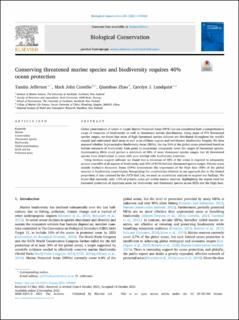| dc.contributor.author | Jefferson, Tamlin | |
| dc.contributor.author | Costello, Mark John | |
| dc.contributor.author | Zhao, Qianshuo | |
| dc.contributor.author | Lundquist, Carolyn J. | |
| dc.date.accessioned | 2022-03-04T10:50:01Z | |
| dc.date.available | 2022-03-04T10:50:01Z | |
| dc.date.created | 2021-12-02T20:34:25Z | |
| dc.date.issued | 2021 | |
| dc.identifier.citation | Jefferson, T., Costello, M. J., Zhao, Q. & Lundquist, C. J. (2021). Conserving threatened marine species and biodiversity requires 40% ocean protection. Biological Conservation, 264: 109368. doi: | en_US |
| dc.identifier.issn | 1873-2917 | |
| dc.identifier.uri | https://hdl.handle.net/11250/2983095 | |
| dc.description.abstract | Global prioritisation of where to locate Marine Protected Areas (MPA) has not considered both a comprehensive range of measures of biodiversity as well as threatened species distributions. Using maps of 974 threatened species ranges, we found that areas of high threatened species richness are distributed throughout the world's coastal and continental shelf areas as well as in offshore regions and well-known biodiversity hotpots. We then assessed whether Representative Biodiversity Areas (RBAs), the top 30% of the global ocean prioritised based on holistic measures of biodiversity from genes to ecosystems, adequately cover the ranges of threatened species. Implementing RBAs could protect a minimum of 30% of most threatened species ranges, but 26 threatened species have distributions in areas with poor overlap with biodiversity priorities. Using decision support software we found that a minimum of 40% of the ocean is required to adequately protect over 68% of all aspects of biodiversity and 30% of IUCN Red List threatened species ranges. Priority areas outside Exclusive Economic Zones (39%) demonstrate the importance of the High Seas (59% of the global oceans) to biodiversity conservation. Recognising the uncertainties inherent in our approach due to the limited proportion of taxa assessed by the IUCN Red List, we used an uncertainty analysis to support our findings. We found that currently, only 2.5% of priority areas are within marine reserves, highlighting the urgent need for increased protection of important areas for biodiversity and threatened species across EEZs and the High Seas. | en_US |
| dc.language.iso | eng | en_US |
| dc.publisher | Elsevier | en_US |
| dc.rights | Attribution-NonCommercial-NoDerivatives 4.0 Internasjonal | * |
| dc.rights.uri | http://creativecommons.org/licenses/by-nc-nd/4.0/deed.no | * |
| dc.title | Conserving threatened marine species and biodiversity requires 40% ocean protection | en_US |
| dc.type | Peer reviewed | en_US |
| dc.type | Journal article | en_US |
| dc.description.version | publishedVersion | en_US |
| dc.rights.holder | © 2021 The Author(s) | en_US |
| dc.subject.nsi | VDP::Matematikk og Naturvitenskap: 400::Zoologiske og botaniske fag: 480::Zoogeografi: 486 | en_US |
| dc.subject.nsi | VDP::Matematikk og Naturvitenskap: 400::Zoologiske og botaniske fag: 480::Marinbiologi: 497 | en_US |
| dc.source.pagenumber | 15 | en_US |
| dc.source.volume | 264 | en_US |
| dc.source.journal | Biological Conservation | en_US |
| dc.identifier.doi | 10.1016/j.biocon.2021.109368 | |
| dc.identifier.cristin | 1963843 | |
| dc.source.articlenumber | 109368 | en_US |

